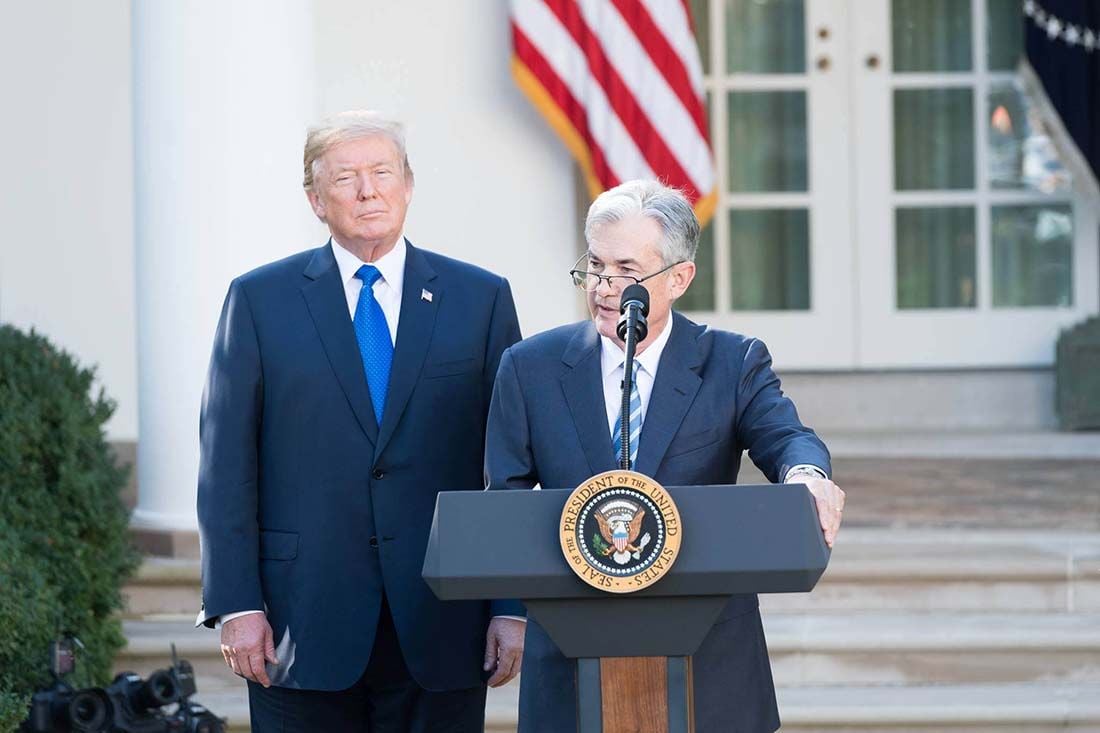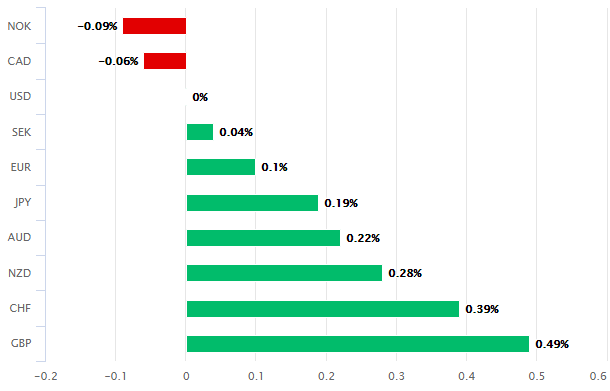Dollar Smiles as Virus Fears Threaten Global Economy and As Federal Reserve Decision Looms
- Written by: James Skinner
-

© The White House
- GBP/USD Spot rate: 1.2992, down 0.51% today
- Indicative bank rates for transfers: 1.2658-1.2749
- Transfer specialist indicative rates: 1.2818-1.2896 >> Get your quote now
The Dollar was riding high Tuesday after being aided by stronger-than-expected economic data and risks posed to the global economy by a rapidly spreading coronavirus, in spite of calls from President Donald Trump for the Federal Reserve (Fed) to cut its interest rate again on Wednesday.
America's Dollar was higher against all but two of its major rivals around the Tuesday close after U.S. durable goods orders, which are an important input for the business investment component of GDP, rose faster than markets anticipated for December.
Orders rose by an annualised 2.4% when markets were looking for only a 1.2% increase, although the more important 'core' measure declined 0.1% when consensus was for a 0.4% gain.
"The 2.4% advance in headline orders [was] driven by a massive 90% gain in defense orders. That masked weakness in orders of both commercial aircraft and autos," says Katherine Judge, an economist at CIBC Capital Markets. "While the detail of this report was disappointing, markets will likely remain focused on the coronavirus and its implications for global growth this morning."

Above: U.S. Dollar performance against major rivals Tuesday. Source: Pound Sterling Live.
Tuesday's data was released barely more than 24 hours ahead of the January interest rate decision from the Fed and amid fresh calls from President Donald Trump for the central bank to cut rates a fourth time.
The Fed should get smart & lower the Rate to make our interest competitive with other Countries which pay much lower even though we are, by far, the high standard. We would then focus on paying off & refinancing debt! There is almost no inflation-this is the time (2 years late)!
— Donald J. Trump (@realDonaldTrump) January 28, 2020
The Dollar strengthened throughout Tuesday's European session even after a tentative improvement in investor risk appetites that saw major economy bond yields pare earlier declines and stock markets recover from Monday's losses.
Dollar resilience comes in part because it remains one of the highest-yielding major currencies but also because it's a safe-haven that naturally benefits from the rapid spread of a new coronavirus that's threatening to bring the world's second largest economy to a near standstill.
China's coronavirus has continued to spread, with one human-to-human transmission being confirmed by Germany's Ministry of Health on Tuesday just days after the U.S. and French governments also confirmed that they are themselves handling multiple cases.
The highly contagious and deadly disease is now present in all but one of China's provinces after first being declared an outbreak early last week.
Above: Pound-to-Dollar rate shown at daily intervals.
The Dollar score its best gain Tuesday over a Pound that was blighted not only by a strong U.S. currency but also a multitude of domestic concerns, including the likely economic impact of the global coronavirus outbreak which has forced investors to reverse Friday's bets in favour of the British unit. More on that here.
Friday saw markets partially reverse wagers suggesting the Bank of England will cut its own interest rate this Thursday but the prospect of it eschewing a cut is fading with the spread of the virus in China. More on that here.
“Wuhan, stay strong”: residents chanted out their windows as they tried to boost morale in the epicentre of the coronavirus outbreak pic.twitter.com/UfAneR7X0d
— SCMP News (@SCMPNews) January 28, 2020
"The outbreak of a new strain of coronavirus in China has sent the country into crisis mode," says Iris Pang, a Greater China economist at ING. "Public transport across several cities including Wuhan, a city of 11 million people has been suspended in an effort to contain the virus from spreading across the country. Schools are expected to remain closed for an extended period following the Chinese New Year holiday. Anyone to have visited Wuhan is required to remain in isolation for 14 days."
One day in #Wuhan through a photographer's lens pic.twitter.com/ABq50qdpG3
— CGTN (@CGTNOfficial) January 27, 2020
Pang says that increasing numbers of Chinese people are likely to opt to remain at home and, if possible, to work from home as awareness of the virus increases. It's now believed the virus can be transmitted from human-to-human while still in its incubation stage, which means it can be passed to others even before carriers begin to show symptoms. Little is known about the new pneumonia-like disease that's spread rapidly and become a national crisis for China within the space of a week.
Wuhan residents are getting creative with how to fight the boredom of being under quarantine amid #CoronavirusOutbreak pic.twitter.com/mvAvRWPhuP
— Al Jazeera English (@AJEnglish) January 28, 2020
Residents of Hubei province's Wuhan city, the epicentre of the outbreak, have taken to shutting themselves indoors in order to avoid infection. But the disease is now present in most provinces, with human-to-human infections rising so it cannot be ruled out that large numbers of people choose to shut themselves away right the way across China. And that would be sure to have economic consequences that reach far beyond the borders of China.
China's National Health Commission said Tuesday that at 24:00 on January 27, it was aware of 4,515 confirmed cases of the new coronavirus, up from 291 less than a week ago on January 21. That's according to a Yandex translation of a notice on the Commission's Chinese language website.
Authorities have declared 977 "severe cases," up from zero on January 21 and 102 on January 22. There were 106 deaths declared as of midnight Monday, up from zero on January 21 and from 9 on January 22. The Commission also said it was tracking 6,973 suspected cases, up from 922 on January 21.
Above: Dollar Index shown at daily intervals alongside Euro-to-Dollar rate (blue line, left axis).
"They are likely to reiterate that global uncertainties still pose downside risks to their outlook for growth which the Fed can now add the potential disruptive impact from the coronavirus. At the same time, the recent data flow from the US has been disappointing resulting in Q4 GDP forecasts being revised lower towards or just below 2.0%," says Lee Hardman, a currency analyst at MUFG. "In these circumstances, we still believe that the risks are skewed towards the Fed’s next policy move being a rate cut rather than a hike, although the Fed is likely to reiterate that they remain comfortable to keep rates on hold this year."
Markets are betting the Fed delivers at least one further interest rate cut in 2020 although the bank itself has said it would require a "material change" of its outlook for GDP growth of around 2% in 2020, with near-target inflation and full employment in order to prompt any further policy action. And so far the economy appears to be delivering the Fed's forecasts on all of those scores.
The Fed's policy stance has been supportive of the Dollar but coronavirus just might qualify as a "material" risk to the outlook even if it hadn't already shown up in the U.S. - which it has - and if Chairman Jerome Powell makes that clear in either Wednesday's 19:00 policy statement or in the 19:30 press conference then the Dollar might wobble. However, that's far from guaranteed if MUFG's Hardman is right in thinking the Fed will be undeterred from its 'on-hold' policy stance by the new virus.
"A 0.25 point cut is now judged as more likely than not by the July FOMC meeting. Nevertheless, the US dollar is well poised to extend its recent advance in more risk-averse trading conditions. The US dollar is also deriving more support from the recent slowdown in the pace of the Fed’s balance sheet expansion. The rising probability of further Fed rate cuts is unlikely to derail the US dollar’s strong start to this year," Hardman says.
